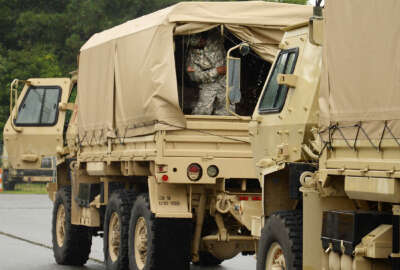Last year the National Guard expanded its training days for armored and Stryker units. Now nine months later, some of the first units are finishing up their lengthened training.
In an exclusive interview with Federal News Radio, National Guard Director Gen. Timothy Kadavy said they must undergo extended training to meet the demands of the nation.
“We don’t have nearly as many of those [units] as we do our infantry brigades and as you look at requirements around the world, they are units that have to maintain higher levels of readiness,” Kadavy said. “The other thing that makes it more complicated is the logistics in supporting large armored and Stryker formations. Logistics in terms of fuels and ammunition and just the large numbers of soldiers in those formations, nearly 4,000, and getting them all on the field at the same time fighting together, maneuvering together.”
The armored brigades, which hold Abrams tanks, and the Stryker brigades now work on a four-year training plan. Members train 39 days in year one, 48.5 days in year two, 60 days in year three and 51 days in year four. That’s compared to 39 days a year of training for other units.
The units train at the National Training Center in southern California.
Kadavy said the units have been settling into the expanded training well.
The 155th Combat Team was one of the first to complete some of the new training this summer before mobilizing.
“I was just recently at the National Training Center and talked to a bunch of soldiers, it must have been four or five hundred soldiers from Mississippi and Kansas… They said this was absolutely some of the best training that they have had in their professional military careers and that goes from the privates to the brigade commander,” Kadavy said.
Another brigade who did some training at the National Training Center last year went to Lithuania this year to capitalize on the training they received.
After completing the first year at the National Training Center, the units in their second year of training spend 21 days doing field training at the platoon level. In year four they go back to the National Training Center to build on the training they received at the platoon level and progress to company level proficiency. They also do combined arms live-fire exercises at the company level as part of a battalion level maneuver.
“It’s something that our Army National Guard units have not done in a long, long time and it’s really about getting us back to our decisive action proficiency to fight at a high-intensity level,” Kadavy said.
The military is focusing more on high-intensity combat as threats from Russia and larger, more traditional adversaries loom.
The military has spent the past 15 years in lower-intensity fights in the Middle East. The Guard says the extra training will reduce the post-mobilization time of the units with the extra training.
Post-mobilization is the time when a unit is called up and is getting ready to deploy. The activities include moving from a home station to a mobilization station, preparing gunnery and doing situation training exercises.
“The whole goal is to reduce post-mobilization time and we think we can reduce it by 30 percent by moving to a four-year model,” Kadavy said in an interview with Federal News Radio in October.
The Guard is still working with families and industry to provide predictability of training so Guardsmen can cope with the stresses of increased training days.
Kadavy said the Guard is open to reviewing expanded training for other units, but is sticking with the plan it has currently.
Copyright
© 2024 Federal News Network. All rights reserved. This website is not intended for users located within the European Economic Area.

